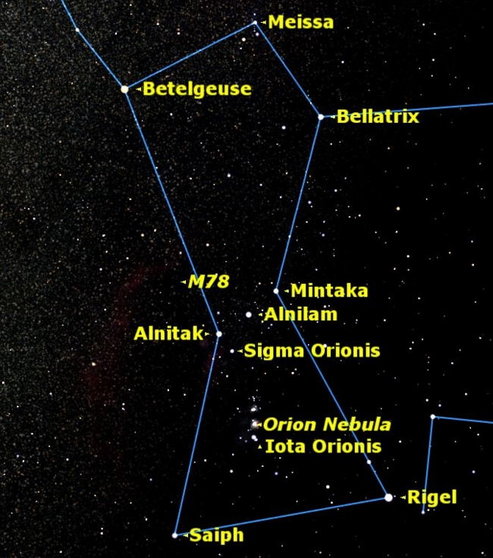Even though in Castilian it is a little modified due to the linguistic evolution, the word JANUARY receives its name from the Roman God Jano (in Latin, Januarius), more evident in other languages such as English (January), or the German, (Januar).
This month we are going to concentrate on the Southern area, but beforehand, I want to remind you that, if the hour of the day we mention it should be cloudy, which we already saw in the first chapter of this series, the same celestial scene will repeat itself the following week, although half an hour earlier. And so to proceed.
Day 1, at 12 midnight. The most impressive constellation is in front of us: Orion (ch. 17), also known as the Giant, the Hunter, or the Centre, full of magnificent stars: the red BETELGEUSE (the underarm of the Central), right next to the Milky Way, at a little less than 3 hands over Coria; the whitish RIGEL (the left leg of the Central), at around 2 hands over Huélaga; BELLATRIX (the war-woman), at a little less than 3 hands above Casas de Don Gómez; and between here and Coria are SAIPH (the sword), at about 2 hands, and the CINTURÓN, formed above and below by ALNITAK (the sash), ALNILAN, (string of pearls) and MINTAKA, (the belt), all about 2 and half hands high. But in addition, Orion has two famous nebula, although on first glance they only look like stains, the HORSE’S HEAD (NGC 2024), a little below Alnitak, and the great NEBULOSA OF ORION (M429), beneath the Belt and a little to the left of Casas de Don Gómez.
To Canis Major, the Great Dog (ch. 16), belongs the most brilliant star of the firmament, also right next to  the Milky Way, SIRIUS (sparkling, burning), one and a half hands to the left of Coria; above it and at the same height, MIRZAM (the herald); WEZEN (the weight), at a little less than a hand and near the right side of Calzadilla, and finally, at the same height, but between Calzadilla and Coria, ADHARA (the virgins).
the Milky Way, SIRIUS (sparkling, burning), one and a half hands to the left of Coria; above it and at the same height, MIRZAM (the herald); WEZEN (the weight), at a little less than a hand and near the right side of Calzadilla, and finally, at the same height, but between Calzadilla and Coria, ADHARA (the virgins).
 In this area we have another two small constellations: Columba, the Dove (ch. 21), with PHAET (from the word “earth”) and WEZEN (the weight), both towards the left of Casas de Don Gómez, and at a height of about three quarters of a hand (all these, which are nearest to the horizon, can be seen better at a later hour), and Lepus, the Hare (Ch. 21), with ARNEB (the hare) at a little over a hand and a half over Casas de Don Gomez, and NIHAL (the camels that quench the thirst), a little less and to the right of its companion.
In this area we have another two small constellations: Columba, the Dove (ch. 21), with PHAET (from the word “earth”) and WEZEN (the weight), both towards the left of Casas de Don Gómez, and at a height of about three quarters of a hand (all these, which are nearest to the horizon, can be seen better at a later hour), and Lepus, the Hare (Ch. 21), with ARNEB (the hare) at a little over a hand and a half over Casas de Don Gomez, and NIHAL (the camels that quench the thirst), a little less and to the right of its companion.
And, once more, Happy and Fairer 2014 ¡!!








